
R a u t a k i N g ā T a k e T ū m a t a t a n u i a
T e O p e K ā t u a o A o t e a r o a 2 5
NZDF PUBLIC AFFAIRS
STRATEGY25
Released under the Official Information Act 1982
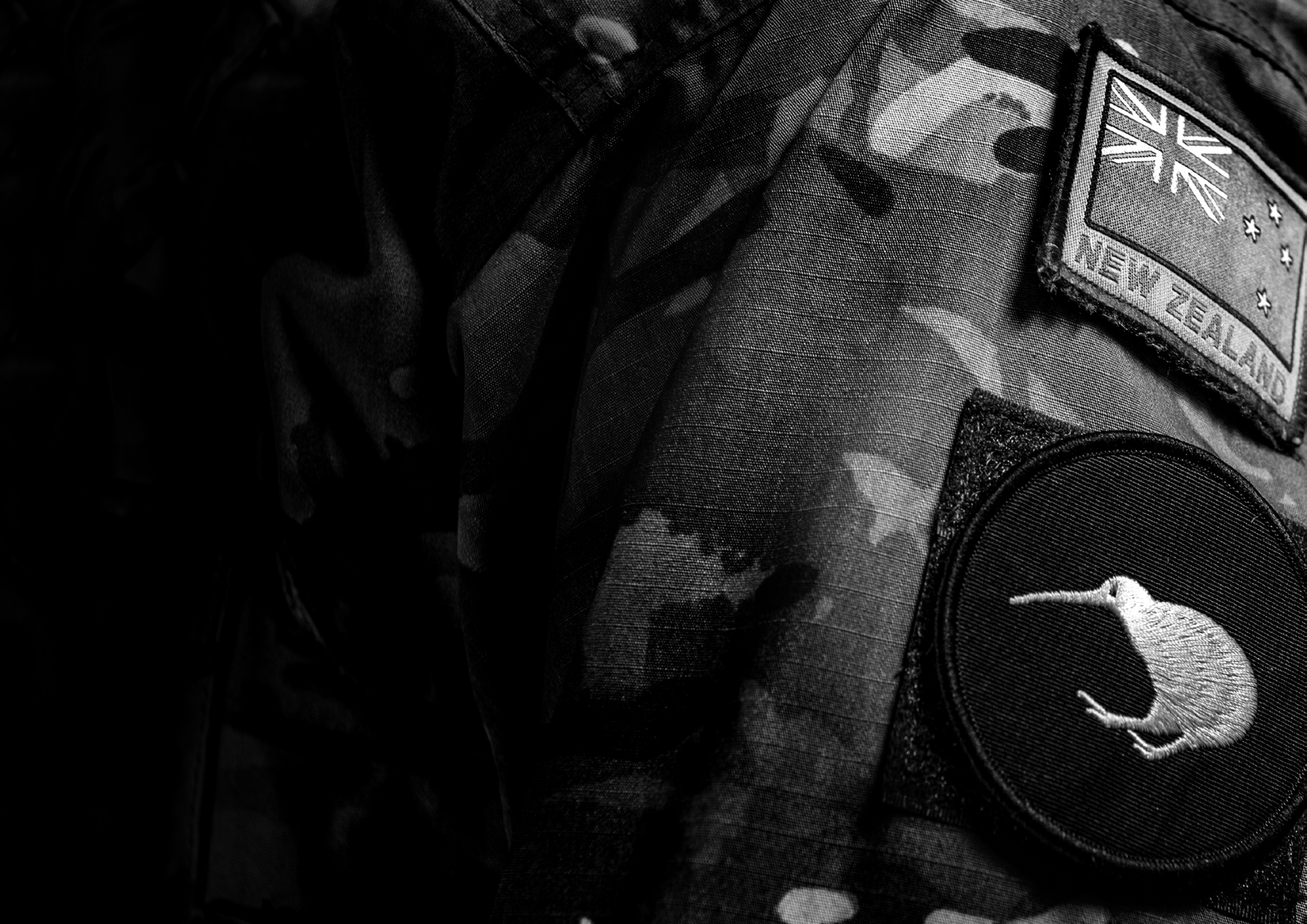
I N T R O D U C T I O N
It supports the NZDF’s Strategy25,
and confidence. The goals of NZDF
This NZDF
and provides guidance to the
public affairs support the purpose of
organisations and personnel of the
public affairs, and directly connect
public affairs
NZDF that play a role in the NZDF’s
to Strategy25.
public affairs.
The resources described in this
strategy is an
The aims of this strategy are to define
strategy are the ‘what’ that NZDF
public affairs in the NZDF, to articulate
uses for public affairs and the
organisation-
the purpose and goals of our public
methods describe ‘how’ the NZDF
affairs and to describe the methods
uses those resources to achieve the
level view of
and resources used to achieve the
strategy goals.
goals. Collectively the goals, methods
the NZDF’s
The strategy is underpinned by the
and resources are the ends, means
NZDF public affairs principles of
and ways of this strategy.
approach to
truthfulness, transparency, alignment,
The definition of public affairs
action, responsiveness and security.
public affairs.
connects public affairs activities of the
This document details the definitions
NZDF with the effect those activities
of those principles.
have on the NZDF’s relationship
Implementation of this strategy
with external and internal publics.
requires supporting plans, policy
The public affairs activities of the
and doctrine. This includes plans
NZDF are much broader than just
for channels, media interaction,
the activities undertaken by Defence
engagement, public affairs
Public Affairs (DPA) as they include
campaigns, education, and
activities of senior leaders, public
monitoring and evaluation.
facing NZDF organisations and our
people as a whole when they engage
The public affairs strategy is
with external and internal publics.
summarised by the ‘plan on a
page’ graphic (on pages 4-5) of
The context for the NZDF public
this publication. The remainder of
affairs strategy is based on
the publication details the context
Strategy25, but also the current
for NZDF public affairs and then
strategic and societal landscape and
explains the elements of the strategy
characteristics. The context connects
represented on the ‘plan on a page’.
the two strategies, as well as other
considerations that inform how NZDF
This strategy was approved on 22 April
should undertake public affairs.
2021 by Chief of Staff HQNZDF following
consultation with Services, portfolios
The purpose of NZDF public affairs
and other key stakeholders.
provides the rationale (the ‘why’)
for NZDF undertaking public affairs,
which centres on relationships, trust,
2
N Z D F P U B L I C A F FA I R S
S T R AT E GY 2 5
N Z D F P U B L I C A F FA I R S
S T R AT E GY 2 5
3
Released under the Official Information Act 1982
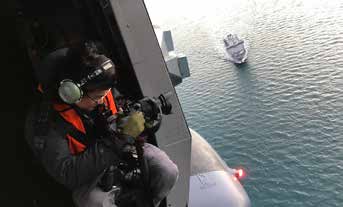
R A U TA K I N G Ā TA K E T Ū M ATATA N U I A
The NZDF conducts public affairs to enhance relationships, strengthen trust,
T E O P E K ĀT U A O A O T E A R O A 2 5
inspire confidence and achieve communication and engagement outcomes, in order
NZDF Public Affairs Strategy25
to enhance the NZDF’s and New Zealand’s strategic and operational effectiveness.
R E S O U R C E S / M E A N S
M E T H O D S / WAY S
G O A L S / E N D S
The NZDF informs, educates and (in
Successful public affairs by the NZDF will support the following Strategy25
appropriate circumstances) persuades
elements, enhancing strategic and operational effectiveness:
identified audiences about the NZDF and
its activities in ways that are consistent
Relationships and Organisational Excellence
with NZDF values, adheres to our legal
Enhanced trust and confidence of the NZ public:
S
requirements, and meets the moral and
• that the NZDF is a professional organisation;
ethical expectations of New Zealanders.
• in the mandate of the NZDF and its activities;
• Public affairs principles-based decisions
• in the investment of the government and public into the NZDF; and
• that the NZDF is transparent and accountable.
The NZDF has a range of resources
• Clear responsibilities, authorities, mandates
that it must use judiciously to achieve
• Key themes and messages – focussed and
public affairs strategic goals.
consistent
Joint Operational Excellence
TIVENES
• People
• Channel, media and engagement plans
A trusted strategic and operational partner through providing
confidence to our international and domestic counterparts.
C
• Information
• NZDF and Service public affairs campaigns
• Relationships
• Tailored public affairs planning and execution
People
• Capability
• Inclusive communications techniques
The NZDF has a skilled and sustainable workforce by attracting and
• Public facing organisations
• Clear, coordinated, consistent internal
developing talented New Zealanders who are informed and motivated.
communications
• Channels
Internal communication enables the success of our workforce by
• Clean, contemporary and consistent branding
keeping our people informed about:
• Activities – operations, exercises,
• the strategic direction and organisational objectives of the NZDF;
courses
• Monitoring, assessment, benchmarking
• NZDF operational, training and readiness activities;
• Recruiting marketing activities
• Risk management
• the tools, resources and opportunities that NZDF provides to
• Social responsibility activities
• Education and training in public affairs for
support their success.
NZDF leaders and personnel
• Public commitments
• Collaboration with counterparts
• Policy and doctrine
Operational Domain Mastery
• Identity and culture
ENHANCED EFFE
Public affairs are synchronised with NZDF integrated information
• Reputation
capabilities to achieve NZDF information objectives.
P R I N C I P L E S : Truthfulness Transparency Alignment Action Responsiveness Security
N Z D F VA L U E S : Tū Kaha | Courage Tū Tika | Commitment Tū Tira | Comradeship Tū Māia | Integrity
4
N Z D F P U B L I C A F FA I R S
S T R AT E GY 2 5
N Z D F P U B L I C A F FA I R S
S T R AT E GY 2 5
5
Released under the Official Information Act 1982
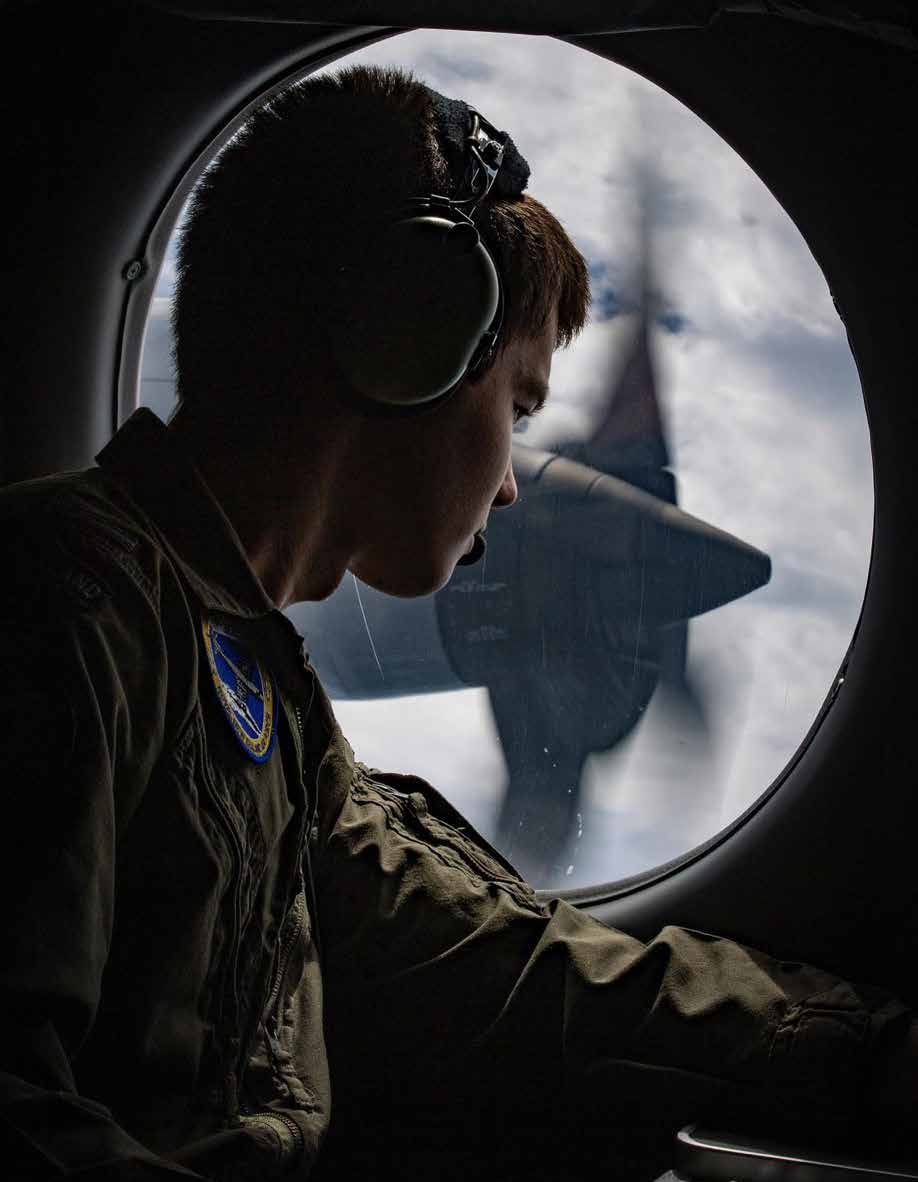

D E F I N I T I O N
What is public affairs
All NZDF
in the NZDF?
personnel (past
The public affairs of the
actions, can and do contribute to
headquarters, reserve units, Service
NZDF includes information
public affairs of the NZDF. Key
museums and Service bands.
and present),
communication and other
NZDF personnel, such as senior
leaders and those in representative
Public affairs can span from
activities that contribute
appointments, have a significant role
the strategic to the tactical and
through their
to the knowledge of NZDF
in public affairs, particularly when
straddle both the organisational and
and attitudes towards its
making public statements.
operational functions of the NZDF as
organisations, activities
shown in the table below. Public affairs
actions, can and
Public facing NZDF organisations,
personnel provide direct support to
and leaders by external and
particularly Defence Public Affairs,
NZDF senior leaders in organisational
internal publics.
Defence Recruiting Organisation,
and operational headquarters as
do contribute to
and Heritage, Commemoration and
well as deployable teams. They can
Public affairs activities are undertaken
Protocol similarly have a significant
provide support remotely either to
to build mutually beneficial
role in NZDF public affairs, along
NZDF personnel overseas or as a
public affairs of
relationships between the NZDF
with other NZDF organisations and
reach-back capability for deployed
and our publics. All NZDF personnel
entities such as camp and base
public affairs teams.
(past and present), through their
the NZDF.
Level of Command
NZDF Organisational Functions
NZDF Operational Functions
Strategic
NZDF/Service to Public Relationships –
Military Strategic Effects Planning,
Trust and Confidence
Advice, Execution
Operational
Public Affairs Support to HQ JFNZ
Public Affairs Support to
Operational HQ Commanders and Staff
Tactical
Issue and Activity Public Affairs
Deployable Public Affairs Teams
Plans and Tasks
planning and executing
6
N Z D F P U B L I C A F FA I R S
S T R AT E GY 2 5
NZDF PUBLIC AFFAIRS
KEY MESSAGES AND THEMES 2021
7
Released under the Official Information Act 1982
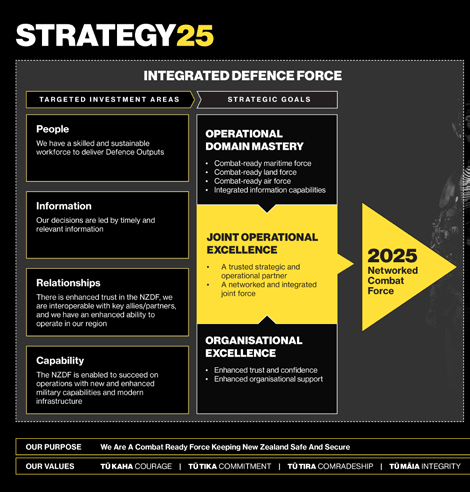
C O N T E X T O F
P U B L I C A F F A I R S
The primary
Public affairs directly contributes to
To maintain and enhance its
a number of the targeted investment
reputation, the NZDF should be active
reference for
areas and strategic goals. The red
with engaging stories, and responsive
boxes highlight those elements of
in a timely and accurate manner, using
the NZDF’s
NZDF strategy that successful public
a wide range of channels, including
affairs will directly contribute to.
traditional media, digital platforms and
public affairs
direct engagement. While the NZDF
The context is also informed by the
strategy is the
as an organisation, and its channels
strategic environment, New Zealand
and statements are trusted, the NZDF
society views and expectations, the
current NZDF
public affairs approach to different
characteristics of the NZDF, and the
ose
The NZDF conducts
public affairs to enhance
relationships, strengthen
trust, inspire confidence
and achieve communication
and engagement outcomes,
in order to enhance the
NZDF’s and New Zealand’s
channels must continue to evolve
media and information landscape.
strategic and operational
strategy –
as the media landscape evolves.
Analysis of these factors (provided in
effectiveness.
We need to be cognisant of the
Appendix 1) demonstrates that public
Strategy25.
reputational risks and opportunities
Public affairs activities are
affairs of the NZDF must clearly and
that the activities we undertake
predominantly undertaken to improve
accurately represent the NZDF and
offer and the consequences of
relationships, primarily by enhancing
the role it plays as part of the
any perceived shortcomings in
trust and confidence. Public affairs
NZ Government.
professionalism and transparency.
can also achieve other NZDF or
New Zealand objectives through its
ability to communicate professionally
prepared information and messages;
integrating written, visual and oral
communication forms; through a
variety of channels to identified
audiences. NZDF stakeholders, which
Purp are audiences for NZDF public affairs,
are described at Appendix 2.
Public affairs effort should be guided
by consideration of how activities
increase the NZDF’s and New
Zealand’s effectiveness in support of
strategic and operational objectives.
8
N Z D F P U B L I C A F FA I R S
S T R AT E GY 2 5
N Z D F P U B L I C A F FA I R S
S T R AT E GY 2 5
9
Released under the Official Information Act 1982
 Successful public affairs by the NZDF supports the
Successful public affairs by the NZDF supports the
following Strategy25 elements, enhancing strategic and
operational effectiveness:
Relationships and
Organisational Excellence
• Enhanced trust and confidence of the NZ public:
— that the NZDF is a professional organisation;
— in the mandate of the NZDF and its activities;
— in the investment of the government and public into the
NZDF; and
— that the NZDF is transparent and accountable.
Joint Operational Excellence
• A trusted strategic and operational partner through providing
confidence to our international and domestic counterparts.
People
• The NZDF has a skilled and sustainable workforce by attracting
and developing talented New Zealanders who are informed and
motivated. Internal communication enables the success of our
workforce by keeping our people informed about:
— the strategic direction and organisational objectives of the
NZDF;
— NZDF operational, training and readiness activities; and
Goals of
— the tools, resources and opportunities that NZDF provides to
support their success.
Operational Domain Mastery
public affairs
• Public affairs are synchronised with NZDF integrated information
capabilities to achieve NZDF information objectives.
Public affairs can’t on its own provide trust and confidence, build trust with
for the NZDF
partners, or provide a skilled and sustainable workforce. However, successful
public affairs will complement the actions of the NZDF to enhance the trust and
confidence of the NZ public and our partners, and improve the workforce by
assisting with the attraction, retention, inclusion and motivation of personnel.
10
N Z D F P U B L I C A F FA I R S
S T R AT E GY 2 5
N Z D F P U B L I C A F FA I R S
S T R AT E GY 2 5
11
Released under the Official Information Act 1982

M E T H O D F O R P U B L I C A F F A I R S
B Y T H E N Z D F
NZDF informs, educates and
(in appropriate circumstances)
persuades identified audiences
about the NZDF and its activities
in ways that are consistent
with NZDF values, adheres to
our legal requirements, and
meets the moral and ethical
expectations of New Zealanders.
The following methods are the ways
The NZDF additionally has the
which NZDF resources are used to
following established norms:
achieve public affairs goals:
• We tell our people first.
Public affairs principles-
• We ensure that information is
based decisions
provided on suitable channels and
platforms.
Public affairs principles provide a
• We are aware of our Treaty of
foundation for public affairs decisions.
Waitangi commitments.
There are inherent tensions between
some principles. The aspiration to be
• We acknowledge and celebrate
both truthful and responsive can create
diversity (including culture,
dilemmas as accuracy can compete
ethnicity, gender, and sexuality)
with timeliness. Similarly transparency
and inclusion.
and security can be in tension where
• We seek to be respectful of
the information in question is sensitive
the local and regional cultural
to the operations, capability or
environment.
personnel of the NZDF or our partners.
The tensions must be recognised and
these principles considered when
these dilemmas exist.
N Z D F P U B L I C A F FA I R S
S T R AT E GY 2 5
13
Released under the Official Information Act 1982
Principles of
Clear responsibilities,
Key themes and messages –
Key themes and messages, and
authorities, mandates
focussed and consistent
their priority, should consider and
be coordinated with how NZDF
Public Affairs
NZDF public affairs is a command
Consistent use of a common set of
represents itself to NZ government,
responsibility at all levels. At the
key themes and messages provides
other government agencies and
highest level, responsibility for the
the greatest opportunity to ensure
international partners and how we
public affairs of the NZDF rests with
those messages resonate with,
articulate that in documents such
the Chief of Defence Force. NZDF
and are remembered by, identified
as the Annual Plan and International
policies, directives and established
audiences. Key themes and messages
Defence Engagement Strategy.
Truthfulness
Action
norms delegate authority for public
for both the NZDF and the Services
affairs responsibilities to staff
support the achievement of NZDF
Transparency
Channel, media and
The credibility of the NZDF
Public affairs requires an
within the Office of the Chief of
and Service public affairs objectives,
engagement plans
Of the public affairs principles,
contributes to operational success.
active posture to frame public
Defence Force and to other NZDF
particularly when the messages are
transparency is a focus
Credibility and trust is earned by
understanding of policies, actions
organisations and appointments.
complementary and the use of them
Clear articulation of how the NZDF
for the NZDF. The NZDF
telling the truth and aligning words,
and events effectively. Without
Clear articulation of responsibilities,
is coordinated.
uses its channels and interacts with
approach to transparency
images and deeds.
action, the advantage is lost. This
authority and mandate as well as
the media to maximise reach and
is based on credibility, trust,
In order to prioritise limited public
may result in the NZDF appearing
regular review and adjustment if
engagement provides consistency
Transparency
respect and openness.
affairs resources it is necessary to
unprepared, uncoordinated and
appropriate, supports public affairs
and clarity when planning to enhance
prioritise key themes and messages.
unresponsive. Delegation of authority
effectiveness.
the success of public affairs activities.
Credibility: We provide
Having focus areas with identified
Transparency is the central pillar
to speak and act on behalf of the
correct information, are
The following table details the
audiences enhances the
Articulation of the purpose and use
of liberal democracy. The NZDF
NZDF empowers our people to take
honest and value the truth
indicative command responsibility
effectiveness of the public affairs
of owned channels (digital and print),
remains accountable to the public
action.
and the role it plays in building
for issues with a public affairs aspect
effort by preventing effort being
and how those channels relate to
at home and on operations. Public
on our reputation.
based upon the nature of the issue,
diluted in an attempt to achieve too
and support each other, is essential
affairs plays a key role in meeting
Responsiveness
Trust: We front up and
noting the responsibility may be
many objectives.
to ensure information is provided on
transparency obligations within
build trust by balancing
adjusted for specific issues
suitable channels and platforms. Over
the requirements of organisational
Public affairs must aim to be timely
responsiveness with security,
when appropriate.
time channels evolve in how they
and operational security. Providing
and accurate in responding to
reflecting at all times the
are used and who they reach. They
named spokespeople for interviews
requests for information or action.
values of NZDF.
become ineffective if their purpose
and statements as a norm, supports
Slow responses erode trust in the
and use isn’t regularly reviewed.
Nature of issue
Responsibility
transparency.
organisation’s transparency. Where
Respect: We respond in a
appropriate, communication may
timely matter and engage
Articulation of how the NZDF
Alignment
High profile/high risk issues
CDF
need to be a two-way engagement
proactively with our audiences
interacts with the media, including
that accounts for the needs of an
and value the role of being
the preparation and approval of press
transparent.
Whole of NZDF organisational issues
CDF or VCDF
Consistent messages support
audience. Public affairs must balance
releases and media responses, as well
the strategic narrative, build
responsiveness with security.
as the identification of spokespeople
Openness: We proactively
credibility and create trust. Public
NZDF organisational issues specific
CDF, VCDF or Portfolio Head
where appropriate, supports all of the
share information where
affairs actions should support the
Security
to a portfolio
(CPO, CFO, CJDS)
public affairs principles.
security considerations
NZDF Public Affairs Strategy. On
permit such as by publishing
Enhancing engagement with
operations, public affairs actions are
Public affairs must protect sensitive
Service issues (raise, train, sustain
Service chiefs, deputies,
corporate documents online.
identified audiences is critical to
coordinated and synchronised with
and confidential information about
and service equipment)
component commanders
ensuring the NZDF is able to reach
other information related capabilities
the NZDF, its activities and people.
those audiences with our messages.
and partners.
Security is paramount but must
Operational issues
COMJFNZ/Commander/
While reaching a large audience isn’t
be balanced with truthfulness
Senior National Officer
necessarily a success, failing to
and transparency. This tension
reach any audience is almost
represents a key challenge for the
Base/Camp/Formations
Commanders/Commanding
certainly failure.
NZDF, its leaders and personnel.
Unit issues
Officers
Security should not be used as an
excuse for being unresponsive.
14
N Z D F P U B L I C A F FA I R S
S T R AT E GY 2 5
N Z D F P U B L I C A F FA I R S
S T R AT E GY 2 5
15
Released under the Official Information Act 1982
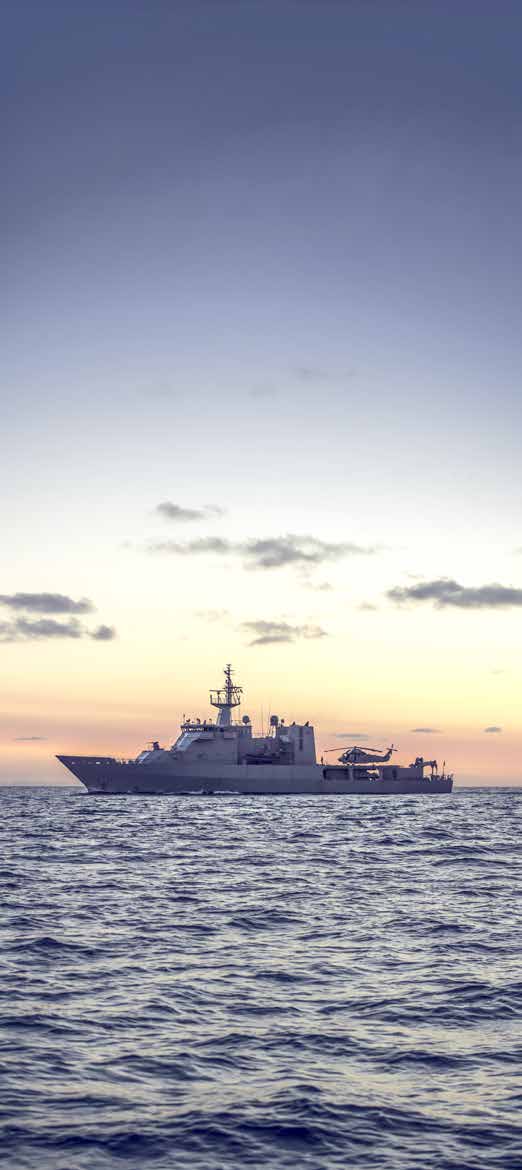 NZDF and Service public
NZDF and Service public
effective representatives of the NZDF.
Monitoring, assessment,
Significant NZDF risk related
Proactive internal
affairs campaigns
It enables NZDF personnel to be
benchmarking
decisions must consider public affairs
informed of organisational direction,
implications including risk mitigation
Public affairs campaigns are a set
objectives, developments, activities
Monitoring and assessment of public
measures specific to the public affairs
of public affairs activities, sustained
and events to enable them to be
affairs, where possible benchmarked
consequences of the risks. Public
communication
over a length of time with objectives
effective in their work and enhance
either against historic measurement
affairs risks can create risks for
their connection and engagement,
other organisation objectives such as
associated with a particular issue or
or counterpart organisations,
thereby enhancing culture and
recruiting and retention.
theme. For key messages that are
enables the success of public
enhances morale
effectiveness.
affairs efforts to be quantified and
focus areas for public affairs effort,
application of effort to be adjusted
Public affairs activities (and this
campaigns offer the opportunity
Application of best practice internal
as required. Assessment of both
strategy) must align with NZDF risk
to increase both effectiveness and
communication methods enables
and empowers
outputs and outcomes provides the
appetite settings. Drawing on the
efficiency in terms of the resources
NZDF to have better informed, more
most comprehensive understanding
NZDF Enterprise Risk Summary and
required to achieve public affairs
effective leaders because internal
of effectiveness. Public perception
risk management methodology assists
outputs and outcomes.
communications provides situational
our people.
surveys by the NZDF now provide
public affairs planning to determine
awareness and puts our leaders
a substantial historic record of
the optimal approach to an issue or
Tailored public affairs
and managers in a better position to
perception trends. Future refinements
activity.
planning and execution
respond to current or future issues
to analysis must consider both the
and to circumvent problems before
consistency of the questions with
Education and training in
The development and execution
they occur.
historic surveys as well as alignment
public affairs for NZDF
of public affairs plans, tailored to
Best practice internal communication
of data collected against strategy
leaders and personnel
the circumstance, is a fundamental
supports crisis communications
goals.
mechanism for undertaking public
by providing trusted, timely
As all NZDF personnel can contribute
affairs. Plans can range from annual
Measurement of this strategy is
channels with reach across the
to or have an effect on NZDF public
organisational level plans to operation,
planned to be informed by the
organisation to inform staff what
affairs, provision of education and
exercise or issue specific plans. While
following surveys:
to do in situations requiring an
training in public affairs can enhance
not all issues require written plans, all
acute response, potentially by a
• Public perception survey for NZ
opportunities and reduce risks.
issues do require considered planning
substantial number of our personnel.
Education and training should be
and where activities or issues span
public related goals.
Change management, whether for
tailored to the roles personnel fill
multiple areas, consistent approaches
structural, cultural or other change
• Pulse survey for NZDF personnel
within the organisation. A learning
to public affairs planning enhances
programmes, can substantially benefit
related goals.
continuum corresponding to career
the likelihood of successful execution.
through consideration of internal
development, complemented by
• NZ government ‘agency overall
communications requirements
role-specific and refresher training
Inclusive communications
and sequencing being determined
satisfaction with NZDF service
provides a comprehensive approach
techniques
in consultation stakeholders and
support’ survey for domestic
to providing our people with public
affected personnel.
counterpart related goals.
affairs skills and knowledge.
Inclusive communications techniques
include not just communicating
Clean, contemporary and
Risk management
Collaboration with
in an accessible manner such as
counterparts
multiple languages, but also by
consistent branding
All of the risk appetite anchors,
incorporating cultural and accessibility
strategic risks and operational risks
A brand is the articulation of an
NZDF Public Affairs effectiveness can
considerations as part of public
identified in the NZDF Enterprise Risk
organisation’s purpose, and the way it
be significantly enhanced through
affairs planning. Application of
Summary have corresponding public
is presented to external and internal
collaboration with counterpart New
these techniques not only provides
affairs risks. Some elements of that
publics. Branding is the creation of a
Zealand government agencies
the opportunity to reach a broader
risk summary such as ‘stakeholder
clear and consistent message for an
and partner military and security
audience, but also to enhance
trust and confidence’, ‘building
organisation. The goal of branding is
organisations in the region and
reputation through how our messages
and maintain trust’ and ‘erosion
to foster understanding and goodwill,
abroad. Effectiveness can be
represent our organisations.
of strategic relationships’ have a
which complements public affairs
enhanced not just by sharing
very direct relationship to public
strategic goals. As such, the use of
knowledge, but also by collaborating
Clear, coordinated,
affairs. Other risks such as ‘strategic
best practice branding methods,
towards the achievement of common
execution’, ‘failure in upholding the
consistent internal
including consistent use of messages
or complementary objectives. In
ethos, values and standards of the
communications
detailing who we are and what we
some circumstances developing
NZDF’, ‘operational effectiveness’
do, as well as a strong visual identity
common approaches and a deeper
and ‘organisational efficiency and
Proactive internal communication
representing the NZDF and its
understanding of other organisations’
affordability’ can all impact the public
enhances morale and empowers
organisations, supports public affairs
practices can substantially enhance
affairs goals of the NZDF.
our people, creating proud and
goals.
effectiveness.
16
N Z D F P U B L I C A F FA I R S
S T R AT E GY 2 5
N Z D F P U B L I C A F FA I R S
S T R AT E GY 2 5
17
Released under the Official Information Act 1982


R E S O U R C E S T H A T C O N T R I B U T E T O
P U B L I C A F F A I R S O F T H E N Z D F
While it is in the interest of NZ to have
•
Information – public affairs
The NZDF
Public facing organisations
•
Defence Recruiting Organisation
be coordinated and aligned to the
a strong relationship between the
inherently involves the
(DRO) – DRO aims to inspire,
achievement of public affairs goals.
NZDF and the NZ public, NZDF must
communication of information.
has a range
While all NZDF personnel can
engage and recruit the number of
ensure it is sparing in the amount of
Ensuring the information is accurate
contribute to public affairs of the
personnel required by NZDF with
Channels
resources utilised for public affairs to
and timely is a responsibility
of resources
NZDF, some organisations within the
the quality and diversity needed
avoid detracting from delivery of core
shared by all that contributes to
NZDF have functions which have
to support Strategy25. Its vision
The NZDF owns a variety of print and
outputs. Judicious prioritisation of
the development, recording and
that it must
a substantial focus on interacting
is to seamlessly connect future
digital channels including the Service
the limited resources of public facing
storage of information, as well
with the NZ public. Within HQ NZDF
generations of sailors, soldiers and
magazines, a variety of NZDF external
organisations of the NZDF is therefore
as the organisation’s information
use judiciously
this includes Defence Public Affairs,
airmen with a career that reflects
websites, social media accounts on
required to achieve the goals of
management systems.
Defence Recruiting Organisation and
their values and goals.
a variety of platforms, and the NZDF
this strategy. Similarly, public affairs
Heritage, Culture and Protocol.
internal intranet and digital poster
•
Relationships – effective
to achieve
•
Heritage, Culture and Protocol
activities, whilst important for NZDF
boards throughout camps and bases.
relationships are critical to public
•
Defence Public Affairs (DPA)
(HCP) is the CDF’s principal policy
objectives, must be cognisant of the
This variety of channels provides a
affairs. Relationships internal to
public affairs
– DPA creates, engages,
advisor on NZDF’s military and
extent of the demand for resources
number of avenues to communicate
the NZDF and well as between
educates and advises to enhance
tikanga ceremonial protocols, its
they create across the organisation
with different audiences. The high
the NZDF and domestic and
strategic goals.
relationships, strengthen
heritage and medallic recognition;
and the resulting tension that may
level of trust the NZDF has with the
international partner organisations
trust, inspire confidence and
planning and delivery lead for the
create against other requirements.
NZ public means our channels are
enables collaboration. Relationships
achieve NZDF communication
organisation of New Zealand’s
considered credible, and provide the
with media and communications
and engagement outcomes.
overseas military commemorations
People, Information,
opportunity to directly engage with a
organisations supports a
The role of DPA is to provide
and NZDF support to state
variety of audiences.
Relationships, Capability
mutual understanding of each
communication, media and public
and national occasions: and
– the Strategy25 Targeted
other’s drivers, constraints and
affairs expertise and services.
organisational lead for CDF-hosted
Activities
Investment Areas.
opportunities.
It develops communication
senior military visits and
strategies and sponsors media and
specified activities.
NZDF operations, exercises, courses
All four targeted investment areas
•
Capability – the capabilities
communications policy; provides
and other activities are the ways in
of Strategy25 contribute to public
developed and maintained by the
media liaison services; manages
Collaboration and coordination between
which NZDF capability is developed
affairs strategy.
NZDF are the means by which
external internet news content
NZDF organisations interacting with
the NZDF delivers its outputs for
or utilised. Telling the story of these
and internal intranet news content;
the public is essential to ensure
•
People – the stories of the people
the NZ Government. The stories
activities, particularly operations and
produces NZDF, Navy, Army and
effort to achieve the objectives of
of the NZDF provide some of our
of those capabilities and their
major exercises is a key component
Air Force magazines; generates,
respective parts of the organisation are
most engaging content. Relatable
value to NZ is therefore central
of the NZDF story. Operations in
processes and/or disseminates
complementary. Numerous other parts
stories that present the human side
to telling the NZDF story. The
particular demonstrate the NZDF
official imagery and video; manages
of the NZDF such as camp and base
of the NZDF have broad appeal and
military capabilities that utilise the
delivering outcomes for the NZ
NZDF social media channels;
headquarters, reserve units, Service
provide the opportunity to engage
equipment such as military ships,
government and public. Given that
produces NZDF graphical products
museums and Service bands can also
sections of NZ public that might not
aircraft, land-based vehicles and
many areas of operations are difficult
and provides subject matter
substantially contribute to public affairs.
otherwise be interested in NZDF
weapons can provide engaging
to access, NZDF resources are critical
expertise in visual identity.
The efforts of those organisations
related issues.
content for a variety of public
to engage the public should also
for developing high quality written and
affairs purposes.
18
N Z D F P U B L I C A F FA I R S
S T R AT E GY 2 5
N Z D F P U B L I C A F FA I R S
S T R AT E GY 2 5
19
Released under the Official Information Act 1982

visual material for communicating the
the NZDF’s reputation, supporting our
public affairs planning
conduct and purpose of operational
public affairs. These include:
and execution.
Appendices
activities within the constraints of
• Rainbow Tick Accreditation.
operational security.
Identity and culture
• White Ribbon Accreditation.
A well-articulated and widely accepted
Recruiting marketing
• Adoption of the United Nations
identity connects the people of the
activities
Women’s Empowerment Principles.
organisation to its public image. The
The NZDF’s primary marketing purpose
• Committing to address the gender
collective purpose articulated as ‘A
is to achieve recruiting objectives. The
pay gap via the Gender Pay Gap
Force for New Zealand’ and the NZDF
public relations industry concept of
Action Plan.
values articulate central components
‘integrated marketing communications’
of NZDF’s identity and provide a frame
provides a philosophy to connect
Policy and doctrine
for public affairs messages.
recruiting activities with public affairs
A range of policy and doctrine
NZDF organisational culture, which
activities that contribute to recruiting
supports the conduct of public affairs
draws on the NZDF values, as well as
objectives. Integrated marketing
of the NZDF.
organisational norms, attitudes, and
communication aims to blend
beliefs is integral to how our people
communication activities towards
• NZ Government, Ministry of
represent themselves. Characteristics
common goals. Close coordination
Defence and NZDF policy, plans
of NZDF culture include our bi-
between public affairs and recruiting,
and strategy provide the context
cultural heritage and our connections
including understanding respective
within which the NZDF exists, and
to the story of New Zealand as a
priorities, aligns to an integrated
its role. These documents inform
nation. The NZDF’s identity and
marketing communications approach.
and drive many of the key themes
culture is central to how the NZDF
and messages for public affairs of
and our people represent themselves,
Social responsibility
the NZDF.
and therefore maintaining a strong
activities
• NZDF orders, instructions and
identity and culture is critical for the
It is in the interests of NZDF
directives provide parameters
NZDF’s public affairs.
relationships with the public to act, and
and explicit tasks for NZDF
be seen to act, as a socially responsible
organisations and personnel
Reputation
organisation. Activities undertaken to
conducting public affairs related
endorse or support causes and charities
activities. Specific orders with
The NZDF has a strong reputation
should be aligned with NZDF values and
direct relevance include those
with the NZ public and many
NZDF objectives. Judicious selection
covering official information,
international groups of importance
of official causes or charities, based on
release of publication into the
to New Zealand. Surveys indicate
alignment of purpose and organisational
public arena and assistance to
that the NZ public perception is
goals, can ensure that effort and effect
community organisations.
consistently high relative to many
counterpart organisations. A strong
isn’t diluted and that the amount of
• Doctrine assists planners and
reputation is hard won but easily lost.
NZDF effort that is contributed to non-
commanders by providing
As such, while NZDF can leverage
core outputs is appropriate.
guidelines on the ‘how’ to plan and
a strong reputation to support its
execute activities in support of
public affairs effort, NZDF must also
Public commitments
objectives. Public affairs doctrine
continuously strive to maintain and
is valuable for standardising
NZDF’s public commitments and
enhance its reputation.
understanding and approaches to
associated accreditations contribute to
References
• New Zealand Defence Force,
Strategy25
• Australian Defence Force Publication,
ADFP 3.13.2 Military Public Affairs, Ed 1, 14 February 2020
• Ronald D. Smith,
Strategic Planning for Public Relations, 5th edition, 2017, Routledge.
20
N Z D F P U B L I C A F FA I R S
S T R AT E GY 2 5
N Z D F P U B L I C A F FA I R S
S T R AT E GY 2 5
21
Released under the Official Information Act 1982
A P P E N D I X 1
A P P E N D I X 2
C O N T E X T A N A L Y S I S
S T A K E H O L D E R A N A L Y S I S
Features
Implication for NZDF
Major Groupings
Sub-groups
Strategic
• Increased competition between
• NZDF needs to be clear about
NZ Public
• General Public (regional/local communities)
environment
major powers, increased use of
how to projects itself publicly
• NZ Government Leadership (inform)
information and mis-information as a
and represents its activities both
tool in that competition.
domestically and internationally to
• NZ Government Agencies
accurately represent the role it plays
• Increased competition in our region.
as part of the NZ Government.
• Iwi
• Media
NZ society view of
• Prospective recruits/staff
• Many New Zealanders are relatively
• NZDF needs to be active with
the NZDF and their
positive about NZDF but ambivalent
engaging stories to connect with
• Career influencers
interaction with
about its role.
the NZ public, including actively
different media
engaging with traditional media and
• While use of social media continues
continued development of social
• Whole of NZDF
to rise, traditional media still achieves
Internal
media.
a much greater reach for NZDF to
• Services (incl/excl Civ staff)
the NZ public than social media.
• Civilian Staff
• Organisations (HQ, Components, Formations, Units)
NZ society
• Increasing expectations for
• Lapses in transparency or failure
• Locations (Defence House, Bases, Camps)
expectations of
transparency of government
to support community and non-
the NZDF
departments including the NZDF.
traditional tasks may present
• Staff led networks
• Increasing expectations of
reputation risks for NZDF.
community involvement and
Defence Community
• Family/friends of NZDF members
contribution to non-traditional
military tasks.
• Former members of NZDF
• Veterans
Characteristics
• NZDF is a relatively small,
• NZDF channels and public
• Cadet forces
of the NZDF
professional force.
statements are generally considered
• NZDF has a relatively high level of
trustworthy by the NZ public.
trust within the NZ population.
Defence Industry
• Domestic
• International
Media/information
• Current trends include convergence,
• NZDF needs to continue to evolve in
trends
increasing use of digital mediums,
its understanding of contemporary
International
• Partner militaries
and increasing prevalence of mis-
media and how to work with it to
information.
• National populations especially in our region
engage with the NZ public.
• Citizen Journalism – anyone can
• Governments
be a journalist as a result of social
• Media
media platforms and smart phones.
Traditional media also use social
media for tip-offs and news.
• New Zealand media appears to be
reaching a degree of stability after
several years of turmoil.
22
N Z D F P U B L I C A F FA I R S
S T R AT E GY 2 5
N Z D F P U B L I C A F FA I R S
S T R AT E GY 2 5
23
Released under the Official Information Act 1982

NZDF PUBLIC AFFAIRS
KEY MESSAGES AND THEMES 2021
24
Released under the Official Information Act 1982












